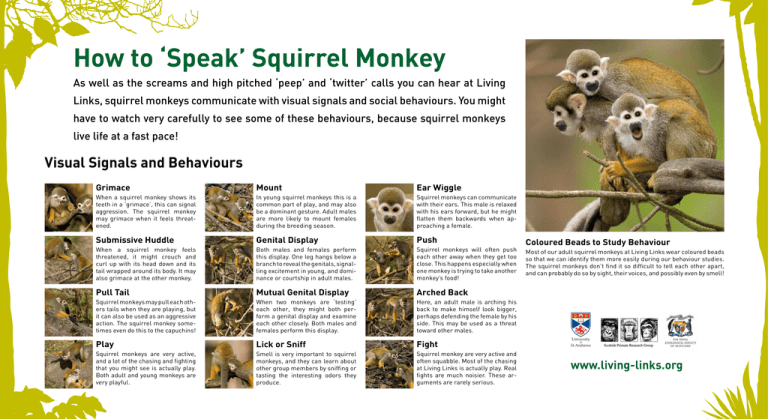How to ‘Speak’ Squirrel Monkey
advertisement

How to ‘Speak’ Squirrel Monkey As well as the screams and high pitched ‘peep’ and ‘twitter’ calls you can hear at Living Links, squirrel monkeys communicate with visual signals and social behaviours. You might have to watch very carefully to see some of these behaviours, because squirrel monkeys live life at a fast pace! Visual Signals and Behaviours Grimace Mount Ear Wiggle When a squirrel monkey shows its teeth in a ‘grimace’, this can signal aggression. The squirrel monkey may grimace when it feels threatened. In young squirrel monkeys this is a common part of play, and may also be a dominant gesture. Adult males are more likely to mount females during the breeding season. Squirrel monkeys can communicate with their ears. This male is relaxed with his ears forward, but he might flatten them backwards when approaching a female. Submissive Huddle Genital Display Push When a squirrel monkey feels threatened, it might crouch and curl up with its head down and its tail wrapped around its body. It may also grimace at the other monkey. Both males and females perform this display. One leg hangs below a branch to reveal the genitals, signalling excitement in young, and dominance or courtship in adult males. Squirrel monkeys will often push each other away when they get too close. This happens especially when one monkey is trying to take another monkey’s food! Pull Tail Mutual Genital Display Arched Back Squirrel monkeys may pull each others tails when they are playing, but it can also be used as an aggressive action. The squirrel monkey sometimes even do this to the capuchins! When two monkeys are ‘testing’ each other, they might both perform a genital display and examine each other closely. Both males and females perform this display. Here, an adult male is arching his back to make himself look bigger, perhaps defending the female by his side. This may be used as a threat toward other males. Play Lick or Sniff Fight Squirrel monkeys are very active, and a lot of the chasing and fighting that you might see is actually play. Both adult and young monkeys are very playful. Smell is very important to squirrel monkeys, and they can learn about other group members by sniffing or tasting the interesting odors they produce. Squirrel monkey are very active and often squabble. Most of the chasing at Living Links is actually play. Real fights are much noisier. These arguments are rarely serious. Coloured Beads to Study Behaviour Most of our adult squirrel monkeys at Living Links wear coloured beads so that we can identify them more easily during our behaviour studies. The squirrel monkeys don’t find it so difficult to tell each other apart, and can probably do so by sight, their voices, and possibly even by smell! www.living-links.org



